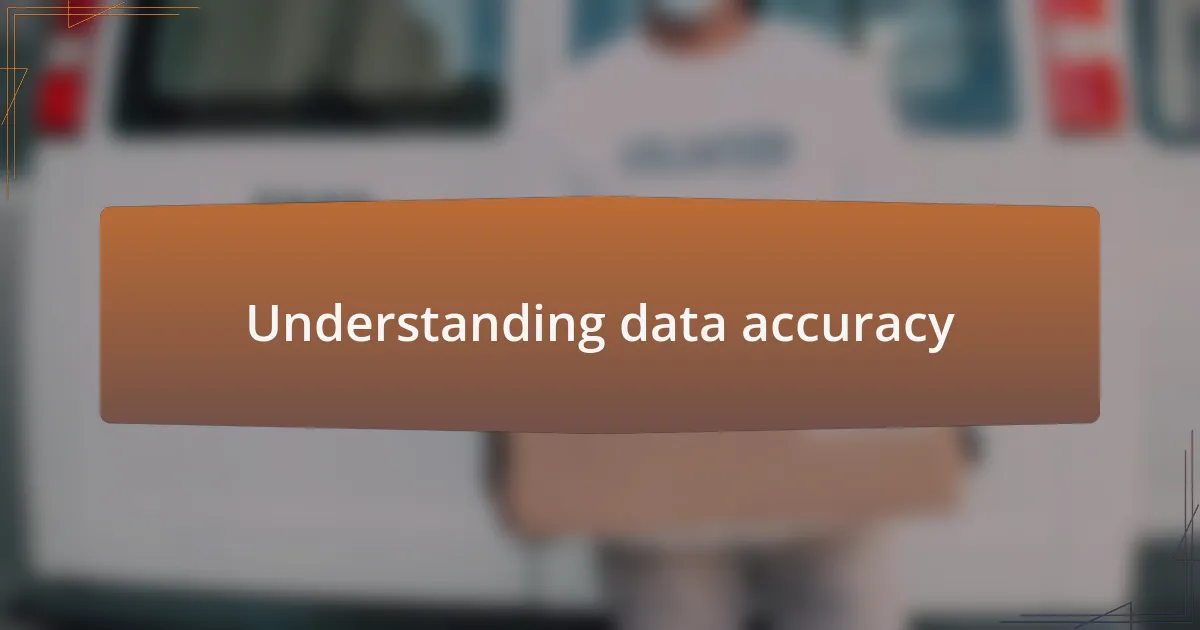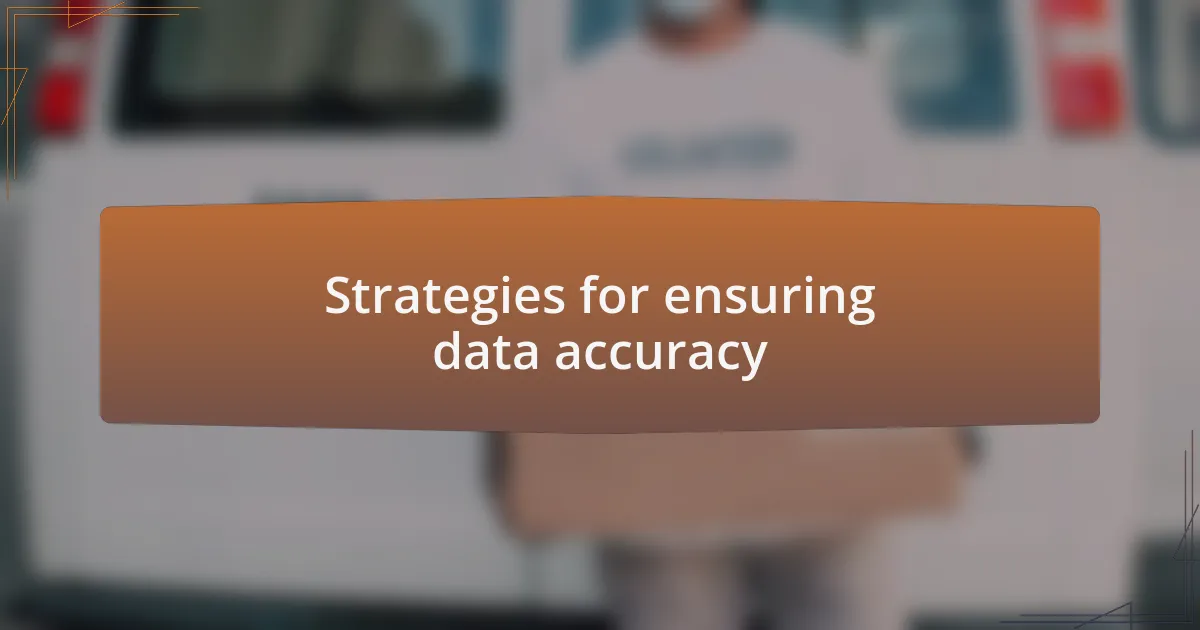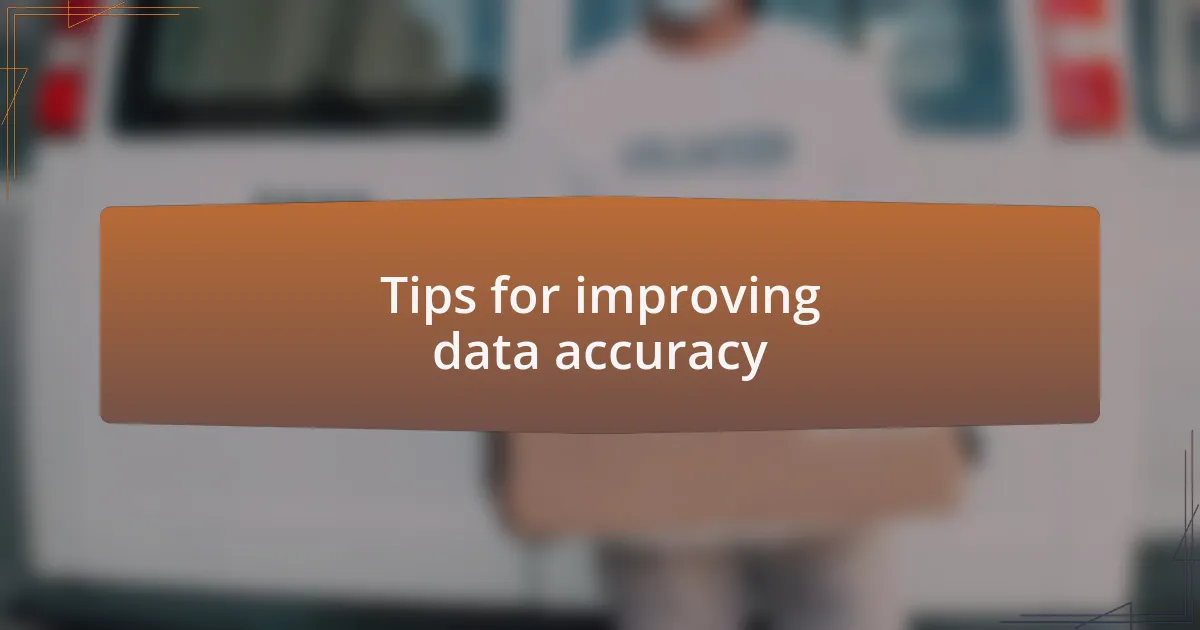Key takeaways:
- Data accuracy is crucial for building trust between donors and charities, impacting both funding and the effectiveness of initiatives.
- Common challenges include human error, outdated information, and data integration issues, which can lead to significant trust issues and inefficiencies.
- Implementing standardized data entry practices, conducting regular audits, and providing training are essential strategies for improving data accuracy.
- Personal experiences highlight the real-world consequences of data inaccuracies, reinforcing the need for meticulous data management in charitable organizations.

Understanding data accuracy
Data accuracy is fundamental to driving effective charitable donations. I recall a time when I researched various nonprofits for potential donations; I was shocked to discover discrepancies in reported financials. How can we trust an organization with our hard-earned money if their data isn’t accurate?
From my experience, inaccurate data can lead to misguided decisions, impacting not only the donors but also the beneficiaries who rely on that support. Have you ever donated to a cause thinking your contribution would make a significant difference, only to find out it wasn’t used effectively? It’s a disheartening realization, and it emphasizes the need for transparency and precise reporting.
Understanding data accuracy is more than just numbers; it’s about building trust and ensuring that every donation counts. When I see an organization deploy data accurately, it gives me confidence in their mission and motivates me to contribute further. It’s crucial for both donors and charities to recognize the importance of solid data for impactful change.

Importance of accurate data
Accurate data is essential because it shapes the narrative of charitable organizations. I remember attending a fundraising event where the host presented impressive figures about their achievements. My initial excitement waned when I realized those numbers didn’t align with independent reports I had researched later. This inconsistency not only confused potential donors but also cast doubt on the charity’s credibility. How can organizations expect to thrive without telling their true story?
In my experience, the ripple effects of inaccurate data extend far beyond the immediate confusion. One time, I donated to a project that later reported fewer beneficiaries than promised due to miscalculations. I felt betrayed, and it made me question whether my contribution had truly impacted lives as intended. These moments remind us that data accuracy isn’t just an operational necessity; it’s the foundation of trust that keeps communities supporting one another. Can we really afford to overlook that?
Furthermore, accurate data serves as a way to measure effectiveness, helping charities learn and grow. When organizations analyze precise outcomes, they can refine their strategies and allocate resources towards the initiatives that work best. I find it inspiring when I see organizations adjust their tactics based on clear data. It shows they care not just about the money, but about making a genuine impact. Isn’t that what we all hope for when we open our hearts and wallets to give?

Common data accuracy challenges
One major challenge to data accuracy is human error in data entry. I recall volunteering for a charity where we had to manually input donor information into a spreadsheet. It was a frenzy of numbers and names, and honestly, it was easy to transpose digits or misspell a name. Such slip-ups might seem trivial, but they can lead to significant issues, like misdirected communications or incorrect tax receipts. Shouldn’t we strive for more precision, especially when people’s trust is on the line?
Another challenge comes from outdated information. I once tried to donate to a charity after seeing a compelling campaign online, but when I reached out to help, I discovered their contact details were years old. This misalignment made me question how effectively they were running their operations. What happens to the countless potential supporters who never make that connection because the data was stale? This experience reinforced my belief that maintaining current and relevant data is crucial for organizations aiming for sustainable fundraising.
Data integration can also pose a significant hurdle. When charities use different systems to track donations and donor interactions, I often see conflicts arise. I’ve spoken with organizations where they couldn’t provide accurate reports because their data sources didn’t align. It makes me wonder: how can donors feel confident in their contributions if charities themselves can’t get a clear picture? Bridging these gaps in data systems is essential for creating a streamlined, trustworthy experience for everyone involved.

Strategies for ensuring data accuracy
Maintaining data accuracy starts with investing in reliable technology. I remember when my local charity switched to a holistic customer relationship management (CRM) system. The transition was a bit daunting, but it helped us simplify data entry and effectively reduce errors. It got me thinking: how much could charities improve their fundraising outcomes if they leveraged technology to streamline data processes?
Regular training sessions for staff and volunteers are another vital strategy. I once attended a workshop focused on data management best practices that completely changed my perception. The hands-on experiences and real-life case studies were eye-opening. When team members are educated about the importance of data integrity and aware of common pitfalls, they become more vigilant. Isn’t it amazing how a little knowledge can go a long way in promoting accuracy?
Lastly, establishing a routine for data audits can be invaluable. I’ve participated in quarterly data reviews where our team analyzed discrepancies and inconsistencies. It was an enlightening experience that fostered accountability. It made me realize that actively checking data not only improves accuracy but also builds a culture of transparency and trust within the organization. How often do we overlook the power of simply revisiting what we’ve collected?

My experiences with data accuracy
When I first started working with data accuracy in charitable donations, I was surprised by how challenging it could be. I vividly remember a time when we reported inflated figures in a fundraising campaign due to inconsistent data entry practices. That experience was a wake-up call; I felt a mix of embarrassment and determination to ensure it never happened again. It prompted me to dig deeper into understanding the impact of accuracy on trust with our donors. Isn’t it unsettling to think how misplaced numbers could shake their faith in our mission?
Another eye-opening moment came during a conversation with a fellow charity worker who shared a heartbreaking story. They discovered a donor had been wrongly listed as inactive, leading to missed opportunities for support. Hearing their frustration made me realize just how real the consequences of data inaccuracies can be. It’s these personal connections that continually drive home the importance of meticulous data maintenance. Have you ever considered how one small mistake could cause a ripple effect within your organization?
Lastly, I recall an incident where we had to rectify our data after a major initiative. The process was tedious but ultimately rewarding. Through that experience, I learned that while maintaining data accuracy requires diligence, it can be incredibly empowering. Each little correction reinforced our commitment to transparency and the impact we were making. Doesn’t it feel gratifying when our data aligns with our mission, creating a clearer narrative for everyone involved?

Tips for improving data accuracy
One effective tip for improving data accuracy is to establish standardized data entry practices. When I implemented a uniform format for entering donation information, the discrepancies significantly decreased. I can’t emphasize enough how much time we saved—did you know that even small variations in format can lead to major headaches down the line?
Regular audits are another crucial step in ensuring data integrity. I remember a period when we dedicated one Friday a month solely to reviewing our records. The findings were eye-opening; we uncovered duplicate entries that had slipped through the cracks. Taking the time to reassess our data not only corrected mistakes but also fostered a culture of accountability among our team. Have you considered how regular check-ins might enhance your organization’s overall efficiency?
Lastly, investing in training for staff on data management tools has been invaluable in my experience. I once attended a workshop on best practices for using our database software, and it transformed the way I approached data accuracy. Providing your team with updated training resources empowers them to take ownership of the information they handle. Isn’t it reassuring to know that with the right skills and knowledge, your team can greatly minimize errors?